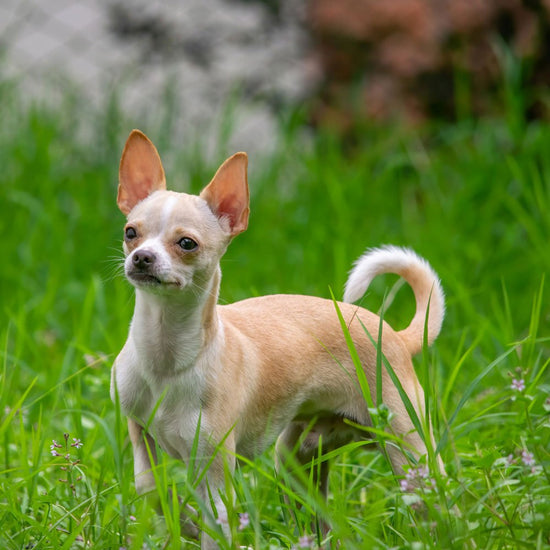

Your basket is currently empty.

Free UK Delivery. Exclusions apply.
Don't miss out! Add these must haves now.
Are you in the right place?
Please select your location so we can direct you to the right store...

Chihuahua
Small, confident and full of character, Chihuahuas hail from Mexico and were bred as companion dogs. Often living well into their teens, when socialised and properly cared for, Chihuahuas can be bold explorers and loving companions. These tiny lap lovers can be a perfect choice for city living, adults on the go, and families with older children.

Whether long- or short-coated, Chihuahuas are instantly recognisable by their big eyes and domed heads. Their alert nature and Rottweiler-worthy boldness mean, in a world that towers over them, they can be prone to barking – but early socialisation can help minimise this.
As companion dogs, Chihuahuas form strong bonds and love attention, ideally on their own terms. If constantly carried or coddled, they may develop hyper attachment and struggle with being left alone.
Because of their small, delicate build, Chihuahuas may be better suited to families with older children who understand how to interact gently with dogs. When not properly socialised or handled with care, some Chihuahuas can become anxious or reactive – which may have contributed to the breed’s reputation for being a little snappy.
It’s also worth noting that so-called ‘teacup’ Chihuahuas – bred to be even smaller – may be more vulnerable to certain health concerns.
This is a congenital condition where fluid builds up in the skull, leading to increased pressure. It can cause signs such as confusion, weakness or an unsteady walk.
These are complex inherited conditions that can sometimes occur together in Chihuahuas. In some cases, they may cause sensitivity or changes in behaviour, which can be discussed with your vet.
Chihuahuas can be more likely to experience overcrowding or retain baby teeth, which may contribute to ongoing dental concerns.
Their large, prominent eyes are adorable, though they can be more vulnerable to minor injuries or eye-related concerns.
Some Chihuahuas may have a more delicate windpipe (trachea), which can sometimes narrow or collapse slightly – especially when they’re excited, overheated or pulling on the lead. This can lead to noisy breathing, often described as a “goose-honk” sound. Using a harness instead of a collar is a gentler option for walks, and in more serious cases, your vet may suggest additional support.
Chihuahuas may be born with congenital heart defects like patent ductus arteriosus (PDA), which can require surgery. This occurs when the shortcut that allows blood to bypass the lungs in the womb fails to close after birth.
Ever seen a Chihuahua hold up its back leg or skip a step? This could be due to a luxating patella, when the kneecap slips out of its groove. It usually pops back as the dog relaxes or straightens the leg, but over time, this repeated slipping can wear down bone and lead to joint concerns. Weight management, joint supplements and appropriate exercise can help support your dog’s mobility, though in some cases, your vet may recommend further intervention.
Though uncommon, this condition is most often seen during the first year of life. It involves a disruption to the blood supply in the hip area, which can affect joint movement and may lead to signs like limping. In some cases, your vet may suggest further support or surgical intervention.
Chihuahuas can have sensitive tummies, and due to their size, even a small amount of a new food can throw things out of balance.
Some Chihuahuas suffer from common dog allergies – whether food-related, environmental, contact-based or flea-associated. If you notice itching, red skin or puffy eyes, it’s a good idea to speak to your vet. Skin and coat support, such as supplements, can also help maintain a healthy skin and coat.
Their Olympic-length lifespan means Chihuahuas can acquire a few medical conditions along the way, especially as they reach geriatric age.
Whole body fits or localised twitching can start at any age. Idiopathic epilepsy generally starts in young adulthood, but other causes can lead to seizures later in life. Treatment depends on the cause, frequency and severity of seizures.
Over time, heart values, especially the mitral valve, can deteriorate. When the heart contracts, leaky valves allow blood to flow in the wrong direction. This can cause further damage and may be audible as a heart murmur. As the problem worsens, congestive heart failure can develop.
Chihuahuas are playful, loyal and full of character – but they require thoughtful care to stay happy and healthy.
Don’t be fooled by their tiny size, Chihuahuas are energetic and intelligent. They thrive with mental and physical stimulation.
For nervous dogs, calming supplements, structured routines and extra physical and mental stimulation can help during periods of stress (e.g., guests or loud noises).
Chihuahuas don’t require intensive grooming, but consistent care is essential.
Brushing:
Bathing:
Chihuahuas feel the cold easily when wet, and regular bathing isn’t essential for their health. Use a mild shampoo only when they’re genuinely dirty.
Ears:
A Chihuahua’s naturally pricked ears are healthier than floppy ones. Cleaning may never be necessary, but it's a good idea to check them regularly for redness or wax buildup.
Eyes:
A little bit of weepiness from those big, beautiful eyes can be normal – wipe gently with a damp cotton pad or water wipe 1-2 times a week.
Dental Care:
This is perhaps the most important grooming task for a Chihuahua. Start young to build trust and slowly introduce tooth brushing with dog-safe toothpaste.
Whether or not brushing is possible, you can also consider: dental diets, dental treats or enzymatic toothpaste to lick from a paw or treat mat.
When you understand and respect their intelligence and quirks, Chihuahuas can be incredibly loving companions – full of energy, loyalty and a touch of sass. They tend to form strong bonds with their people and bring a whole lot of personality into everyday life.

Footer